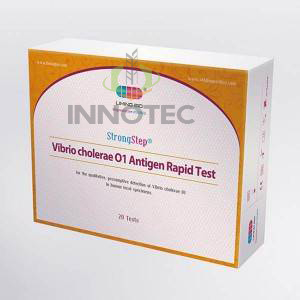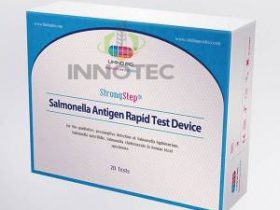INTRODUCE
Cholera, caused by V.cholerae serotype O1, It continues to be a disease of global significance in many developing countries.. Clinically, cholera can go from asymyboms to severe diarrhea with heavy dehydration, this leads to dehydration., electrolyte disorders and death. In. cholerae O1 causes this discharge diarrhea by entering the small intestine and producing strong cholera bacterial toxins., Due to the clinical and epidemiological importance of cholera, it is important to determine as quickly as possible whether the organism from the patient with O1-positive water diarrhoea is present.. A quick method., The simplicity and reliability to detect V. cholerae O1 is a great value for clinicians in disease management and for public health officials in establishing control measures..
PRINCIPLE
Vibrio antigen rapid tester for O1 (Manure) Detect Vibrio cholerae O1 through visual explanation of color growth on the inner band. Vibrio cholerae O1 antibodies are fixed on the test area of the membrane. During testing, the sample reacts with anti-Vibrio cholerae O1 antibodies in combination with colored particles and is coated first on the sample plate of the test. Then, the mixture moves through the membrane thanks to the action of capillaries and interacts with reeds on the membrane. If there is enough Vibrio cholerae O1 in the specimen, a color range will form at the test area of the membrane. The presence of this color range indicates a positive result, while its absence indicates a negative result. The appearance of the color range in the control zone serves as procedural control, shows that the appropriate sample volume has been added and that membrane peeling occurs.
PREVENTIVE MEASURES
• Only used for professional diagnosis in vitro.
• Do not use after the expiration date stated on the packaging. Do not use the test if the foil bag is damaged. Don't reuse the tests..
• This set contains products of animal origin. Certified knowledge of origin and / or the sanitary status of the animal does not fully guarantee that there are no infectious pathogens. So, we recommend that these products be treated as potentially contagious and treated by complying with conventional safety precautions. (for example: not eating or inhaling.).
Avoid cross-contamination of samples by using a new sample container for each sample obtained.
Read the entire process carefully before the test..
• Not eating, drinking or smoking in any area where specimens and instruments are handled. Treat all diseases as if they contain infectious agents. Follow established precautions against microbiological risks throughout the process and follow standard procedures for proper sample handling. Wear protective clothing like a lab coat., disposable gloves and eye protection when testing samples.
• Sample dilution buffer solution containing sodium acid, this substance can react with lead or copper water pipes to form a potentially explosive metal acid.. When throwing away sample dilution buffers or extracted samples, always flush with plenty of water to prevent azit buildup.
• Do not change or mix reeds from different batches.
Humidity and temperature can adversely affect the results.





























Join – :
Quality products, good preservation, easy to use